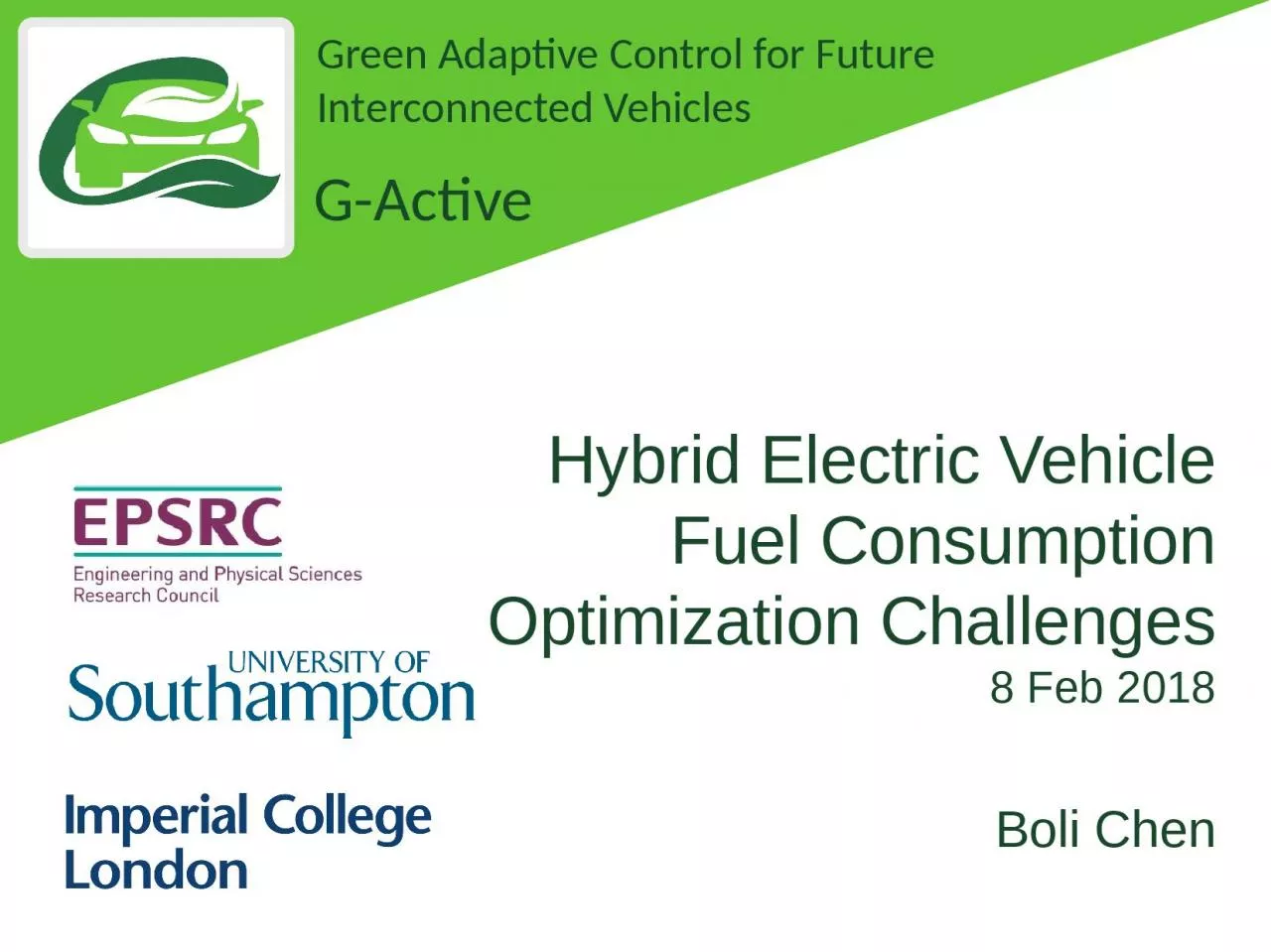

8 Feb 2018 Boli Chen Hybrid Electric Vehicles Multiple power sources engine battery A variety of architectures Series Nissan enote BMW i3 range extender Parallel Preor Posttransmission ID: 927561
Download Presentation The PPT/PDF document "Hybrid Electric Vehicle Fuel Consumption..." is the property of its rightful owner. Permission is granted to download and print the materials on this web site for personal, non-commercial use only, and to display it on your personal computer provided you do not modify the materials and that you retain all copyright notices contained in the materials. By downloading content from our website, you accept the terms of this agreement.
Slide1
Hybrid Electric Vehicle Fuel Consumption Optimization Challenges
8 Feb
2018
Boli Chen
Slide2Hybrid Electric Vehicles
Multiple power sources: engine + battery
A variety of architectures Series Nissan e-note, BMW i3 range extenderParallelPre-or Post-transmissione.g., KIA Optima, Honda CR-ZThrough the roade.g., BMW i8Split powere.g., Toyota Prius, Lexus CTCharging solutions: Plug-in or non-plug-in
UK car market:
2,690,000 new cars (2016)2.8% are hybrids66% of hybrids are non-plug-in HEVs
Slide3Series HEV Model
battery
D
fuel
tank
DC/DC converter
electric motor/ generator
electric generator
AC/DC rectifier
DC link & inverter
IC engine
medium size passenger car
mass 1500 kg
combustion engine 86 kW
electric motor 120 kW
battery 1.5kWh 300V
model inputs
Battery power (can be negative)
Engine power
Mechanical braking power
model states
vehicle: speed, travelled distance
fuel mass
battery: state of charge,
battery temperature, state of health (only for monitoring)
Slide4Optimization Challenges
Driving Speed Optimization (OCP 1)
ConventionalExtension to hybridEnergy Management of Hybrid Energy Sources (OCP2)Conventional approaches A Globally tuned heuristic methodDriving speed and power split simultaneous optimization (OCP 3)Case study based on real-world driving dataCombine optimization vs two-step optimizationAuxiliary SystemsEngine Cooling Battery coolingEM + cooling combined optimization
Slide5Driving Speed Optimization
Drive mission:
road geometryheadingcurvatureslopes travel time i.e., average speedPulse and glide (PnG): rapid acceleration to the maximum followed by a period of coasting or gliding downSolved extensively for conventional vehicles
Example
: 1km Straight road
Slide6HEV Driving Speed Optimization
Extension to a hybrid vehicle
Energy recovery factor:Subject to Constraints: speed limitAdherence of tires (acceleration ellipse/diamond)Boundary condition: Travel time OCP formulation:
: total power from powertrain
: mechanical braking power
: total driving power
Slide7HEV Energy Management
Energy management of Hybrid energy sources
Speed profile is givenStandard test cycles e.g., EUDC, WLTP, etc.Real driving speed profilesControl Target: Fuel minimization + Charge sustaining Solve the optimal power splitAlgorithmOptimalityVehicle ModelReal-timeDPOptimal Highly simplifiedNoPMPOptimal or Sub-optimalSimplifiedNoReceding Horizon (MPC)Optimal or Sub-optimal
Medium-fidelityConditionalECMSSub-optimal
High-fidelityConditionalRule-basedSub-optimalRealistic Yes
Slide8Globally Tuned Heuristic EM Strategy
Threshold changing + load leveling operating rules
Three design parametersdetermine where and when to operate PS The method is inherently charge sustainingHighly resembles DP solutions for simple model --- 1%-2% fuel increase for the WLTP cyclesSlightly better than ECMS for complex model
Slide9Simultaneous Optimization of Speed and EM
Advantages:
removes the necessity of knowing a priori the driving cycle, which is unknown in practiceremoves the necessity of speed prediction, which can leads to a sub-optimal solutionSaves more fuel than two-step optimization the drive mission can be easily defined by the user or measured by a navigation systemcan be extended to incorporate uncertainties, e.g., road traffic, traffic lightsDisadvantages:increased complexity
Route
Travel time
HEV powertrain model
Optimization algorithm
Driving speed
Power split
Speed optimization
Energy management
Speed constraints
operation constraints
Slide10Case Study: Rural Road Driving in the UK
distance ∼18.9 km
travel time 22 minsaverage speed 51.3 km/hscarce traffic Data collected with ADAM
Slide11Optimal Control Formulation
3
Objective Control inputs Boundary conditions:Initial and terminal conditions: SOC, power inputs, travel timejerk of the associated power inputs: battery, ICE, brakefor smooth controlsavoid unrealistic jerky manoeuvres.Constraints:
Operation: power and SOC limitsSafety and comfort: speed limit, acceleration diamond
Solver:
PINS – a PMP based OCP solver
Minimize fuel consumption
Slide12Comparative Results
Advantages of optimized speed profile:
More efficient and foresightedStrictly obeys the speed limit CombinedTwo stepsEMBattery life [km]157500 12770089573 Average fuel consumption [km/L]26.0624.5116.9
Slide13Comparative Results
The influence of the road slope behaves like additive disturbance
The energy recovery factor affects the optimized speedThe minimum fuel of the speed only optimization is influenced by the selection of energy recovery factor
Slide14Auxiliary Systems – Engine cooling
HEV thermal management (cooling)
Enginethe most power consuming actuator: pump + fanIdeal coolant temperature 90 °C Chemical energy
Cooling system
Waste heat
Propulsion
Convective heat transfer
Slide15Auxiliary Systems – Battery Cooling
Convective heat transfer
BatteryCooled by the AC systemIdeal operational temperature: 15 °C- 35 °C
Air cooling
Internal resistance
Ohm heating
Slide16Optimal Control Formulation
4
Drive cycle: average speed 50km/h4km travel distanceControl inputs
Power split
: battery, engine, brake powerBattery cooling: power taken by AC system
Engine cooling: pump
speed and fan speed
Control target
Minimize fuel consumption
Keep b
attery
temperature
15
°C-
35
°C
Keep engine coolant
temperature 90
°C
“soft”
constraints
EM + thermal management
PINS – a PMP based OCP solver
S
olver
:
Very high complexity
Further simplification is needed for cooling systems
Slide17Comparative Results
1
No cooling : optimized power split (without cooling) Optimal cooling: simultaneous optimization of power split and the operation of the cooling systemsMore battery is used when the cooling is taken into considerationBattery generates less heatMore efficient cooling
Blue: engine
Red: battery Green: brakesSolid: with cooling Dashed: without cooling
Cooling control
Average fuel [km/L]
No cooling
29.1
O
pitmal
cooling
28.5
PID
cooling
28.3
The improvement of optimization over PID is about 0.7%.
It is expected to reach about 1.5% after further improvement of optimization scheme
PID cooling (non-optimal)
:
optimized power split (without cooling) + PID controlled cooling systems